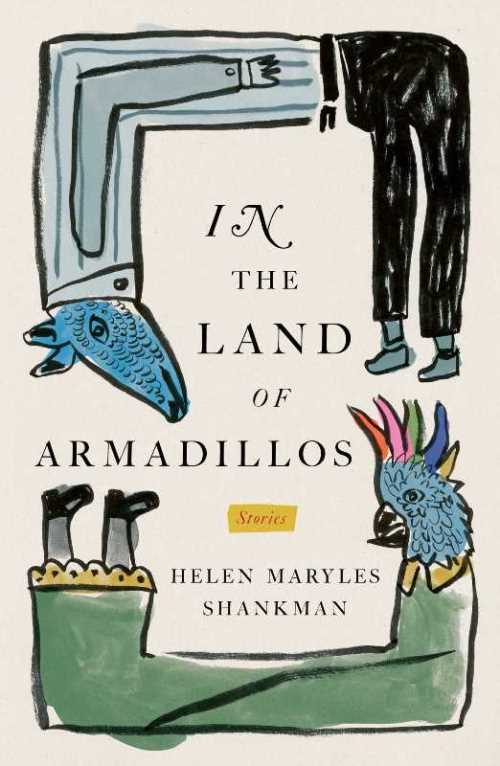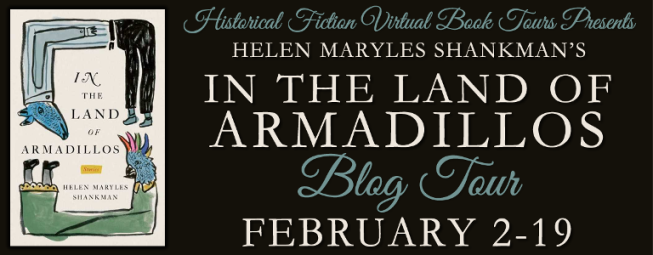
In the Land of Armadillos: Stories by Helen Maryles Shankman
Publication Date: February 2, 2016
Scribner/Simon & Schuster
eBook & Hardcover; 304 Pages
Genre: Historical Fiction/WWII/Short Stories/Literary

A Spring 2016 Discover Great New Writers selection at Barnes & Noble.
A radiant debut collection of linked stories from a two-time Pushcart Prize nominee, set in a German-occupied town in Poland, where tales of myth and folklore meet the real-life monsters of the Nazi invasion.
1942. With the Nazi Party at the height of its power, the occupying army empties Poland’s towns and cities of their Jewish populations. As neighbor turns on neighbor and survival often demands unthinkable choices, Poland has become a moral quagmire—a place of shifting truths and blinding ambiguities.
Blending folklore and fact, Helen Maryles Shankman shows us the people of Wlodawa, a remote Polish town: we meet a cold-blooded SS officer dedicated to rescuing the creator of his son’s favorite picture book, even as he helps exterminate the artist’s friends and family; a Messiah who appears in a little boy’s bedroom to announce that he is quitting; a young Jewish girl who is hidden by the town’s most outspoken anti-Semite—and his talking dog. And walking among these tales are two unforgettable figures: the enigmatic and silver-tongued Willy Reinhart, Commandant of the forced labor camp who has grand schemes to protect “his” Jews, and Soroka, the Jewish saddlemaker and his family, struggling to survive.
Channeling the mythic magic of classic storytellers like Sholem Aleichem and Isaac Bashevis Singer and the psychological acuity of modern-day masters like Nicole Krauss and Nathan Englander, In the Land of Armadillos is a testament to the persistence of humanity in the most inhuman conditions.
Praise
“Moving and unsettling…Like Joyce’s Dubliners, this book circles the same streets and encounters the same people as it depicts the horrors of Germany’s invasion of Poland through the microcosm of one village…Shankman’s prose is inventive and taut…A deeply humane demonstration of wringing art from catastrophe.” – Kirkus Reviews
“Every story in this remarkable collection reveals Helen Maryles Shankman’s talent for surprising, disturbing and enlightening her readers. Blending the horrors of war with the supernatural, she creates a literary landscape that is strangely mythical and distinctively her own. These stories haunted me for days after I finished reading them.” – Sarai Walker, author of Dietland
“With unflinching prose and flashes of poetry Helen Maryles Shankman spirits her readers back through history to the Polish hamlet of Wlodawa during the dark days of Nazi occupation. Horrific reality and soaring fantasy meld in serial stories that include an avenging golem, an anti-Semite who shelters a Jewish child, brutal SS officers who lay claim to ‘their own Jews’ and an unlikely messiah whose breath smelled of oranges and cinnamon. That scent will linger in the memory of readers as will the haunting stories in which barbaric hatred is mitigated by the reflection of a survivor who reflects that love is a kind of magic. There is, in fact, literary magic in these well told tales.” – Gloria Goldreich, author of The Bridal Chair
“Populated with monsters and heroes [human and perhaps not], but mostly with ordinary people caught up in horrific events they neither understood nor controlled – this series of intersecting stories drew me in completely, making me read them again to find all the connections I missed the first time. The writing is fantastic, and I marvel at Shankman’s literary skills.” – Maggie Anton, author of the bestselling Rashi’s Daughters trilogy
“In The Land of the Armadillos is a moving collection of beautifully written short stories that readers of Jewish fiction will celebrate. Not to be missed.” – Naomi Ragen, author of The Sisters Weiss
About the Author
Helen Maryles Shankman lived in Chicago before moving to New York City to attend art school. Her stories have appeared in numerous fine publications, including The Kenyon Review, Cream City Review, Gargoyle, Grift, 2 Bridges Review, Danse Macabre, and JewishFiction.net. She was a finalist in Narrative Magazine's Winter Story Contest and earned an Honorable Mention in Glimmer Train's Short Story Award for New Writers competition. Her story, They Were Like Family to Me, was nominated for a Pushcart Prize. Shankman received an MFA in Painting from the New York Academy of Art, where she was awarded a prestigious Warhol Foundation Scholarship. She spent four years as as artist's assistant and two years at Conde Nast working closely with the legendary Alexander Liberman. She lived on a kibbutz in Israel for a year, spending the better part of each day in an enormous barn filled with chickens, where she collected eggs and listened to the Beatles. Shankman lives in New Jersey with her husband, four children, and an evolving roster of rabbits. When she is not neglecting the housework so that she can write stories, she teaches art and paints portraits on commission. In the Land of Armadillos, a collection of linked stories illuminated with magical realism, following the inhabitants of a small town in 1942 Poland and tracing the troubling complex choices they are compelled to make, will be published by Scribner in February 2016.
Blog Tour Schedule
Tuesday, February 2 Review at Worth Getting in Bed For
Wednesday, February 3 Review at Library Educated
Spotlight & Giveaway at It's a Mad Mad World
Thursday, February 4 Review at A Chick Who Reads
Friday, February 5 Guest Post & Giveaway at A Literary Vacation
Monday, February 8 Review at Oh, for the Hook of a Book!
Tuesday, February 9 Interview at Oh, for the Hook of a Book!
Wednesday, February 10 Spotlight & Giveaway at Passages to the Past
Thursday, February 11 Review at I'm Shelfish
Monday, February 15 Review at Back Porchervations
Tuesday, February 16 Guest Post at The Lit Bitch
Wednesday, February 17 Review at Cynthia Robertson's Blog
Friday, February 19 Review at Ageless Pages Reviews
a Rafflecopter giveaway



 Log in with Facebook
Log in with Facebook 











